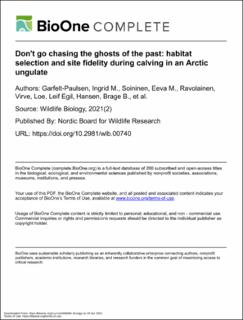| dc.contributor.author | Paulsen, Ingrid M. | |
| dc.contributor.author | Soininen, Eeva M | |
| dc.contributor.author | Ravolainen, Virve | |
| dc.contributor.author | Loe, Leif Egil | |
| dc.contributor.author | Hansen, Brage Bremset | |
| dc.contributor.author | Irvine, Justin R | |
| dc.contributor.author | Stien, Audun | |
| dc.contributor.author | Ropstad, Erik | |
| dc.contributor.author | Veiberg, Vebjørn | |
| dc.contributor.author | Fuglei, Eva | |
| dc.contributor.author | Pedersen, Åshild Ønvik | |
| dc.date.accessioned | 2021-05-12T11:56:05Z | |
| dc.date.available | 2021-05-12T11:56:05Z | |
| dc.date.created | 2021-04-29T10:42:53Z | |
| dc.date.issued | 2021 | |
| dc.identifier.issn | 0909-6396 | |
| dc.identifier.uri | https://hdl.handle.net/11250/2755180 | |
| dc.description.abstract | Predator avoidance and food availability are both factors known to influence habitat selection and site fidelity around calving in caribou and reindeer. Here, we assess habitat selection and site fidelity during the calving period in the solitary, Arctic Svalbard reindeer Rangifer tarandus platyrhynchus, which is subject to limited predation risk and human disturbance. In this largely predator-free environment, we explore and discuss if habitat selection during the first week after calving is driven by food availability or remnants of anti-predatory behaviour. Based on GPS-collar data and ultrasound scanning (2009–2017; n = 134 individual-years) from two study areas, we estimated individual calving dates using recursive partitioning and first passage time and compared habitat selection and site fidelity of reproductive versus non-reproductive females. The K-select analysis suggested similar habitat selection during calving in reproductive and non-reproductive females. Female reindeer generally selected for lowland, flat habitats with high proportion of heath and moss tundra, i.e. habitats typically rich in terms of forage plants. Individuals producing a calf had significantly higher site fidelity in the calving period compared to the null model, and the mean distance between consecutive years' calving areas ranged between 1.5 and 3.9 km. Our study provides support for the prediction that in the absence of significant predation, ungulate calving site selection in the Arctic is mainly driven by the availability of spatially and temporally varying food resources. | en_US |
| dc.language.iso | eng | en_US |
| dc.publisher | Nordic Council for Wildlife Research | en_US |
| dc.rights | Navngivelse 4.0 Internasjonal | * |
| dc.rights.uri | http://creativecommons.org/licenses/by/4.0/deed.no | * |
| dc.title | Don't go chasing the ghosts of the past: habitat selection and site fidelity during calving in an Arctic ungulate | en_US |
| dc.type | Peer reviewed | en_US |
| dc.type | Journal article | en_US |
| dc.description.version | publishedVersion | en_US |
| dc.subject.nsi | VDP::Zoologiske og botaniske fag: 480 | en_US |
| dc.subject.nsi | VDP::Zoology and botany: 480 | en_US |
| dc.source.volume | 2021 | en_US |
| dc.source.journal | Wildlife Biology | en_US |
| dc.source.issue | 2 | en_US |
| dc.identifier.doi | 10.2981/wlb.00740 | |
| dc.identifier.cristin | 1907161 | |
| dc.relation.project | Egen institusjon: NP | en_US |
| dc.relation.project | Norges forskningsråd: 267613 | en_US |
| dc.relation.project | Egen institusjon: Norwegian institute for nature research (NINA) | en_US |
| dc.relation.project | Norges forskningsråd: 223257 | en_US |
| dc.relation.project | Norges forskningsråd: 276080 | en_US |
| dc.relation.project | Andre: Svalbard Environmental Protection Fund | en_US |
| dc.relation.project | Egen institusjon: UiT The Arctic University of Norway | en_US |
| dc.relation.project | Egen institusjon: The James Hutton Institute | en_US |
| dc.relation.project | Egen institusjon: Norwegian University for Life Sciences | en_US |
| dc.relation.project | Egen institusjon: Norwegian University of Science and Technology | en_US |
| cristin.ispublished | true | |
| cristin.fulltext | original | |
| cristin.qualitycode | 1 | |

